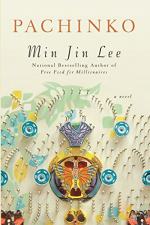
|
| Name: _________________________ | Period: ___________________ |
This test consists of 5 short answer questions, 10 short essay questions, and 1 (of 3) essay topics.
Short Answer Questions
1. What does Sunja find from the graveyard groundkeeper in Book Three, Chapter 21?
2. What does Noa think about Akiko asking questions about him in Book Two, Chapter 18?
3. Why does Etsuko's husband divorce her as described in Book Three, Chapter 9?
4. What does Yoseb tell Changho in Book Two, Chapter 14?
5. What happens when Sunja goes to Koh Hansu's Osaka house in Book Two, Chapter 20?
Short Essay Questions
1. Where does Etsuko finally find Hana in Book Three, Chapter 15? What does Etsuko do when she sees her?
2. In Book Three, Chapter 21, what does Sunja find inside her bag while at Isak's grave and what does she do with it?
3. What does Noa's letter to Sunja and the Baek family say Book Two, Chapter Twenty after he learns Hansu is his father?
4. What case does Haruki go to investigate in Book Three, Chapter 7? What does Haruki learn when he meets the boy’s parents?
5. How does Sunja feel seeing Hansu in the kitchen with her in Book Three, Chapter 4?
6. Why does Mozasu tell Yumi they can not move to America in Book Three, Chapter Two?
7. What does Kuroda-san lecture about the Jewish people in Daniel Deronda that Akiko reacts against in Book Two, Chapter 15?
8. Why does Phoebe find it difficult to live in Japan as described in Book Three, Chapter 16?
9. Why is Mozasu promoted to foreman of Paradaisu Seven in Book Two, Chapter 16?
10. Why does Sunja go to Koh Hansu with Noa in Book Two, Chapter 13 What does Koh Hansu say?
Essay Topics
Write an essay for ONE of the following topics:
Essay Topic 1
At the end of the novel, David Copperfield is brought up as Noa's favorite novel. Why does he like this particular book? Choose another example of intertexuality in the book (such as the Bible, the book of "Hosea, "Daniel Deronda," the epigraphs at the beginning of each book). How do these stories map out and connect to the story in the novel? Do some background research and pull excerpts from the intertextual sources to support its connection to Pachinko. How does having multiple examples of intertextuality expand different sections of the text?
Essay Topic 2
Do some research on the idea of "diaspora." Kim Changho returns to Korea because he longs to see his homeland. Noa eventually becomes a Japanese citizen and travels back to Korea. Meanwhile, the other members of the family are unable to get Japanese passports and can only have Korean passports, which are useless, and so they can not travel internationally or back to Korea. All of these events relate to longing for a homeland, diaspora, and the regulation of human bodies moving across geography. Use the concept of diaspora to focus on two characters in the novel and examine their connection to a homeland, their in-betweenness of identity and belonging, and how they navigate the policing of their bodies. How do they navigate heartache, pain, humiliation, and difficulties? Explain what diaspora is in relation to them.
Essay Topic 3
How is Pachinko arranged as a whole novel? Examine the structure of Pachinko in the first section, the second section, and the third section. Why is the novel divided in this way? What does each section say on its own, as an individual book? What is the message of the three sections put together overall? Consider the titles of each section as well as the epigraphs. What does the structure of the novel and the use of three sections say about the story as a whole? Use textual evidence to support your answers.
|
This section contains 1,260 words (approx. 5 pages at 300 words per page) |

|




